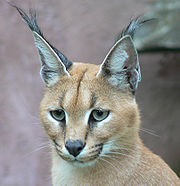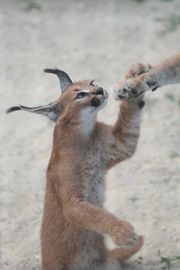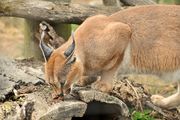Caracal
| Caracal[1] | |
|---|---|
 |
|
| Conservation status | |
| Scientific classification | |
| Kingdom: | Animalia |
| Phylum: | Chordata |
| Class: | Mammalia |
| Order: | Carnivora |
| Family: | Felidae |
| Subfamily: | Felinae |
| Genus: | Caracal Gray, 1843 |
| Species: | C. caracal |
| Binomial name | |
| Caracal caracal (Schreber, 1776) |
|
| Type species | |
| Caracal melanotis Gray, 1843 (= Felis caracal Schreber, 1776) by monotypy |
|
| Synonyms | |
|
Felis caracal |
|
The caracal (Caracal caracal, pronounced /ˈkærəkæl/) is a fiercely territorial medium-sized cat ranging over Western Asia and Africa. The word caracal comes from the Turkish word "karakulak", meaning "black ear"[3]. In North India and Pakistan, the caracal is locally known as syahgosh (स्याहगोष/سیاحگوش) or shyahgosh, which is a Persian-derived term meaning black ears.[4] Although it has traditionally had the alternative names Persian Lynx, Egyptian Lynx and African Lynx, it is no longer considered to be an actual lynx. Instead, it is now believed to be closely related to the African golden cat and the Serval. The caracal is classified as a small cat, yet is amongst the heaviest of all small cats, as well as the quickest, being nearly as fast as the serval.
Contents |
Description
The caracal is a slender, yet muscular, cat, with long legs and a short tail. Males typically weigh 13 to 18 kilograms (29 to 40 lb), while females weigh about 11 kilograms (24 lb).[5] The caracal resembles a Eurasian Lynx, and for a long time it was considered a close relative of the lynxes. It has a tail nearly a third of its body length, and both sexes look the same. The caracal is 65 to 90 centimetres (26 to 35 in) in length, with a 30 centimetres (12 in) tail. Compared to lynxes, it has longer legs, shorter fur, and a slimmer appearance.
The colour of the fur varies between wine-red, grey, or sand-coloured. Melanistic (black) caracals also occur.[3] Young caracals bear reddish spots on the underside; adults do not have markings except for black spots above the eyes and small white patches around the eyes and nose. Underparts of chin and body are white, and a narrow black line runs from the corner of the eye to the nose.[3]
The pupils of a caracal's eyes contract to form circles rather than the slits found in most small cats.[6] The most conspicuous feature of the caracal is elongated, tufted black ears, which also explain the origin of its name, karakulak, Turkish for "black ear". A juvenile has black on the outside of the ears, which disappears as it becomes an adult[6]. Its ears, which it uses to locate prey, are controlled by 20 different muscles.
The feet of a caracal have numerous stiff hairs growing between the pads. These probably help the animal walk on soft sand. The jaw is short and equipped with powerful teeth. About 92 percent of caracals lack the second upper premolar teeth.[7]
Habitat and diet

The caracal is distributed over Africa and the Middle East. Its chief habitat is dry steppes and semideserts, but it also inhabits woodlands, savannah, and scrub forest[8]. They generally prefer open country, so long as there is sufficient cover, in the form of bushes and rocks, from which to ambush prey.
It hunts at night (but in colder seasons also in the daytime) for rodents and hares; rarely it attacks animals larger than itself, such as gazelles, small antelopes, or young ostriches. It is a picky eater, and discards the internal organs of the mammals it catches, partially plucks the fur off hyraxes and larger kills, and avoids eating hair by shearing meat neatly from the skin. However, it will eat the feathers of small birds and is tolerant of rotten meat. It is among the smallest felids to attack prey larger than itself.[7]
Its life expectancy in the wild is 12 years, and 17 years in captivity. The caracal may survive without drinking for a long period — the water demand is satisfied with the body fluids of its prey. Since it is also surprisingly easy to tame, it has been used as a hunting cat in Iran and India[3].
Behaviour
Adult caracals dwell either alone or, less commonly, in pairs. Females inhabit relatively small home ranges, varying from 5 to 57 square kilometres (1.9 to 22 sq mi), depending on the local availability of prey. While the females actively defend their territory against other females, the males roam over much larger areas of 19 to 220 square kilometres (7.3 to 85 sq mi) with considerable overlap.[7]
Like other cats, caracals scent mark their territory. They leave their faeces in visible locations, and also mark territory by spraying urine onto bushes or logs, or raking it into the ground with their hind feet.[7]
Caracals hunt by stalking their prey, approaching within about 5 metres (16 ft) before suddenly sprinting and leaping. They kill smaller prey with a bite to the nape of the neck, and larger animals by biting the throat and then raking with their claws. Caracals sometimes cover their larger prey if they cannot consume the whole carcass in a single meal, and return to it later. Some have even been observed to hide carcasses in trees.[7]
It is best known for its spectacular skill at hunting birds, able to snatch a bird in flight, sometimes more than one at a time. It can jump and climb exceptionally well, which enables it to catch hyraxes better than probably any other carnivore. If no cover is available in which to conceal itself, a caracal may flatten itself against the ground and remain motionless, allowing its coat colour to act as camouflage.[7]
Caracals produce the usual range of sounds for cats, including growling, hissing, purring, and calling. Unusually, they also make a barking sound, which is possibly used as a warning.[7]
Reproduction and life cycle

Mating may occur at any time of year; however, it is more likely to occur when prey is plentiful, which stimulates estrous in females[9]. The estrous cycle lasts two weeks, and is marked by the female spraying urine containing chemical cues advertising her receptivity to neighbouring males.
The female typically mates with several males over the course of a number of days. In some areas, males have been observed to fight aggressively for access to females and remain with her for several days to guard against rivals; in others, they appear to be less protective. Copulation lasts anything from 90 seconds to ten minutes.[7]
Gestation last 68–81 days, and litter size ranges from one to six kittens. For litters born in their natural environment, the maximum number of kittens is three; however, larger litters are more likely to occur in captivity where nutrition needs are adequately met[9]. Before birth, the female prepares a den in a cave or other sheltered area, sometimes using the abandoned burrows of other animals. At birth, the kittens are blind and helpless, weigh 198 to 250 grams (7.0 to 8.8 oz), and have yellow to reddish brown fur with black markings. The eyes open at around ten days, and the deciduous teeth have fully developed by fifty days. The canines are the first permanent teeth to appear, at around four or five months, with the others following over the next six months.[7]
Kittens are able to leave the birthing den at around one month old, and at about this time the mother will begin regularly moving them to new locations. Kittens are weaned at about ten weeks, but may stay with their mother for up to one year, when they start to reach sexual maturity.[10] Life expectancy in the wild is twelve years, and seventeen years in captivity.
Conservation

Caracals are often viewed as vermin by farmers in Africa as they may prey on domesticated livestock such as poultry and young sheep and goats[11]. Caracals are rarely seen in the wild despite their relative abundance, as they hide extremely well. Game drives in countries such as Kenya and Botswana widely encounter other animals, but a sighting of a caracal is extremely rare.
Because it is so easily tamed, the caracal is sometimes kept as a pet and can adapt to living with humans[12]. The caracal has been hybridised with the domestic cat at the Moscow Zoo.[13]
Subspecies
- Caracal caracal caracal, East, Central and South Africa
- Caracal caracal algira, North Africa
- Caracal caracal damarensis, Namibia
- Caracal caracal limpopoensis, Botswana
- Caracal caracal lucani, Gabon
- Caracal caracal michaelis, Turkmenistan (endangered)
- Caracal caracal nubica, Ethiopia, Sudan
- Caracal caracal poecilotis, West Africa
- Caracal caracal schmitzi, Israel, West Asia, Iran, Arabia, Pakistan, India, Jordan
References
- ↑ Wozencraft, W. Christopher (16 November 2005). "Order Carnivora (pp. 532-628)". In Wilson, Don E., and Reeder, DeeAnn M., eds. Mammal Species of the World: A Taxonomic and Geographic Reference (3rd ed.). Baltimore: Johns Hopkins University Press, 2 vols. (2142 pp.). pp. 533. ISBN 978-0-8018-8221-0. OCLC 62265494. http://www.bucknell.edu/msw3.
- ↑ Breitenmoser, C., Henschel, P. & Sogbohossou, E. (2008). Caracal caracal. In: IUCN 2008. IUCN Red List of Threatened Species. Downloaded on 18 January 2009. Database entry includes justification for why this species is of least concern
- ↑ 3.0 3.1 3.2 3.3 "SCI recordbook -Caracal". Safari Club International. http://www.scirecordbook.org/caracal/. Retrieved 2009-06-10.
- ↑ D.L. Drake-Brockman; Drake-Brockman, D.L (1909). Volume 1 of District Gazetteers of the United Provinces of Agra and Oudh. Government Press, United Provinces, India. pp. 552. http://books.google.com/?id=-zJuAAAAMAAJ. "... The caracal (felia caracal) or syahgosh is also found in the Dun ..."
- ↑ "Cats from A to Z". National History Museum of Los Angeles County. http://www.nhm.org/cats/. Retrieved 2009-05-31.
- ↑ 6.0 6.1 http://www.honoluluzoo.org/caracal.htm
- ↑ 7.0 7.1 7.2 7.3 7.4 7.5 7.6 7.7 7.8 Sunquist, Mel; Sunquist, Fiona (2002). Wild cats of the World. Chicago: University of Chicago Press. pp. 37–47. ISBN 0-226-77999-8.
- ↑ "Smithsonian National Zoological Park Field Tag". http://nationalzoo.si.edu/ConservationAndScience/AZA/FelidTAG/Species/Factsheets/caracal.cfm. Retrieved 2009-06-06.
- ↑ 9.0 9.1 "Animal Diversity Web-Caracal". University of Michigan Museum of Zoology. http://animaldiversity.ummz.umich.edu/site/accounts/information/Caracal_caracal.html. Retrieved 2009-06-10.
- ↑ "Caracal". International Society for Endangered Cats (ISEC) Canada. 2001. http://www.wildcatconservation.org/Caracal_%28Caracal_caracal%29.html. Retrieved 6 February 2010.
- ↑ http://www.scienceinafrica.co.za/2004/january/caracal.htm
- ↑ http://www.animalorphanagekenya.org/members/brandy_for_breakfast.php
- ↑ Kusminych, I, and Pawlowa, A (1998). "Ein Bastard von Karakal Hauskatze im Moskauer Zoo". Der Zoologische Garten 68 (4).
External links
|
|||||||||||||||||||||||||||||||||||||||||||||||||||||||||||||||||||||||||||||||||||||||||||||||||||||||||||||||||||||||||||||||||||||||||||||||||||||||||||||||||||||||||||||||||||||||||||||||||||||||||||||||||||||||||||||||||||||||||||||||||||||||||||||||||||||||||||||||||||||||||||||||||||||||||||||||||||||||||||||||||||||||||||||||||||||||||||||||||||||||||||||||||||||||||||||||||||||||||||||||||||||||||||||||||||||||||||||||||||||||||||||||||||||||||||||||||||||||||||||||||||||||||||